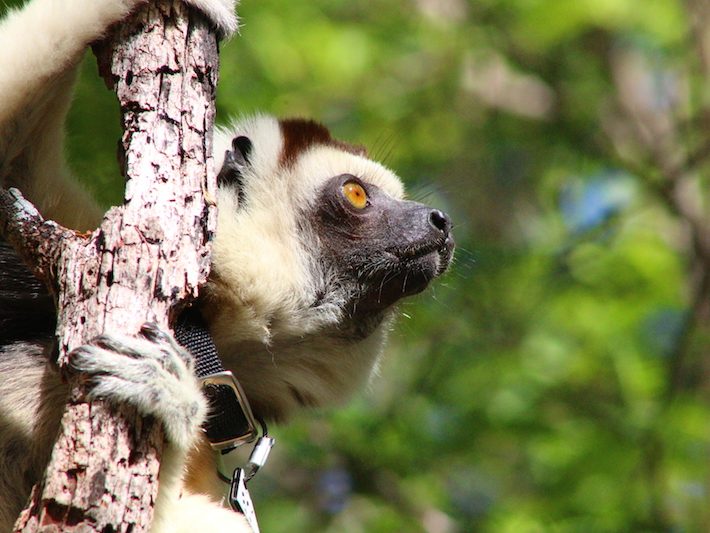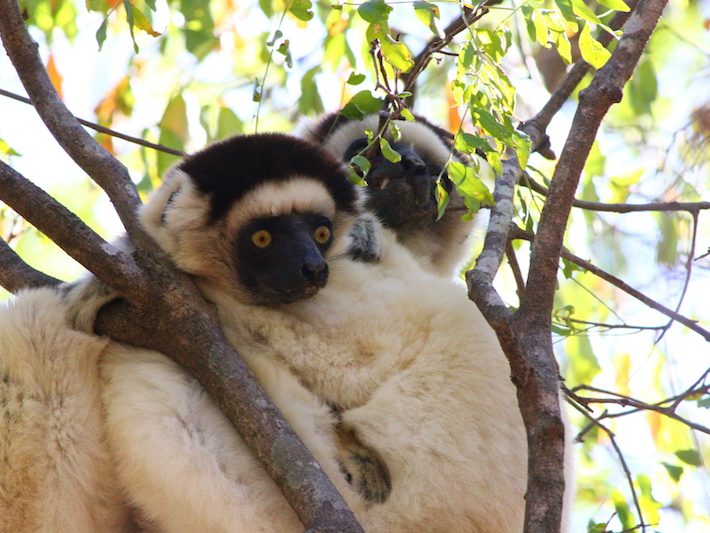Lemur Life: David Anderson ’19 Researches a Madagascar Primate
By Rebecca Goldfine







As a biology major at Bowdoin, David Anderson ’19 has had the chance to study the behavior of sparrows on Kent Island and crabs at the Schiller Coastal Studies Center. But to satisfy his curiosity about primates, he (obviously) needed to go farther afield than New Brunswick and Maine.
“I’m generally interested in animal behavior and I’m also really interested in human behavior, and primatology is really interesting from that perspective,” Anderson said, just 48 hours after flying back into the United States. While Lemurs share an ancient common primate ancestor with monkeys and humans, they evolved along a different lineage.
This summer, the Bowdoin senior traveled to a remote corner of Madagascar, the only place in the world where wild lemurs live, to contribute to a research project that is forging new insights into the ways humans and lemurs can harmoniously co-exist on the island nation.
After securing a grant from the Career Planning’s funded internship program to support his travel and living expenses, Anderson joined the longterm project of Chloe Chen-Kraus, a PhD student in Yale University’s Department of Anthropology.
For ten weeks, with Chen-Kraus and two researchers from Madagascar—Njara Anick Raharinoro and Miravo Randrianirnarisoa—Anderson collected field data on how three different management plans for a wildlife reserve might be affecting a small population of Verreaux’s sifaka lemurs. This kind of knowledge is important for conservation efforts and wildlife management.
These first two weeks of #fieldwork are training weeks. We have a big team this year and are practicing IDing individuals and collecting behavioral data. pic.twitter.com/xtcK92FfrT
— Chloe Chen-Kraus (@endangeredlemur) June 23, 2018
Sifaka lemurs, pronounced shi-fakah, are named for the distinctive sound of their call — “shi-FAK.” The Verreaux’s sifaka lemur have luxuriant white fur that looks loosely draped over their gangly limbs, and their golden eyes pop in their black faces. They leap from tree to tree with astonishing speed and spring; and when they travel on land, they bound upright on their long back legs. Like all lemurs, they are endemic to the African island nation of Madagascar, and they are endangered.
After flying into the capital city of Antananarivo and stocking up on supplies, Anderson and his research team took two days of driving, on highways and rough back roads, to arrive at the Bezà Mahafaly Special Reserve in southwest Madagascar.
Based at a small field station, Anderson set off each day for eight hours to observe the behavior of several groups of the sifaka. His team focused on groups that lived in one of the preserve’s three management areas: the original parkland, first protected three decades ago; a more recently protected area contiguous to the park; and a sustainable-use buffer zone around the reserve that allows some human activity.
Every day, the researchers would spy on a different lemur for twenty-minute blocks, recording every action they saw, from sleeping to snacking. They’d also note details, such as GPS coordinates, what was being eaten, how high in a tree the lemur was at the time, etc. Then, they’d redirect their focus to the next lemur in the rotation. In this way, they didn’t get distracted by one or two lemurs doing something particularly noteworthy.
While they’re still analyzing data, Anderson said that the research has already revealed an important finding for the ecology field. Ecologists, he said, tend to make assumptions that animals they’re studying are less disturbed in a protected area than in a mixed area shared with humans. However, “one of the things we noticed is that the disturbance frequency [when an animal gets stressed by a perceived threat, say a human or goat] doesn’t necessarily vary across the zones as you would expect,” he said. “It is instead relatively even across the board.”
So while human activity, especially livestock grazing, has led to the decline in sifaka populations, Chen-Kraus has found that some sifakas can survive well within disturbed areas. She has said this could potentially lead to more effective management policies that, while restricting the most harmful human behaviors, are also flexible enough to allow local communities to maintain their livelihoods.
For Anderson, the summer was a “great way to explore the fields I’m interested in: behavior, conservation, primatology, and ecology.” He also recognized the value for researchers, especially those working in international conservation, to spend a long time living and working in a region, learning the language and getting to know the people, culture, and history.
“It is important for people to go to those places, familiarize themselves with the history of those places, the people living there, and with how the natural environment has been used historically,” he said. “It is important for researchers, particularly to have face-to-race familiarity with the systems they’re studying.”



